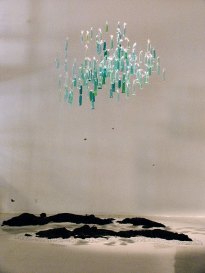New Stories: Aurora Borealis and the Melting Tundra, 2008
Installation
Staller Center for The Arts, Stony Brook, NY, USA
This sound and tactile installation is based upon stories and experiences of climate change and global warming in northern Canada. Fur and gravel create a pseudo-landscape on the floor with the “northern lights” above. The ground is made of faux bear fur laced with butterflies and the gravel is mixed with sparkles and barely-discernible litter. Furry plants with music boxes inside, complete with revolving butterflies, play familiar tunes when wound alone, but when wound together they create a sickening, tinkling cacophony. The moving shadows created by a randomly revolving pinwheel above the overhanging bags of coloured water, mimicking the northern lights, make the path flow, and “freeze.”
The metaphors and atmosphere of the piece is created in response to testimonials of Canadians living the arctic about climate change; the points of view may vary, but taken together they have an effect of something overwhelming and alarming. A flyer describing how to reduce carbon dioxide emissions was also available.
Much of the research for New Stories: Aurora Borealis and the Melting Tundra came from the International Institute for Sustainable Development’s trip reports to Sacchs Harbour, stories from acquaintances, and the video Sila Alangotok.
These quotes are mainly from Inuit, Metis, and other peoples living in Sachs Harbor and other parts of northern Canada. They hung on the gallery wall in front of the installation.
“Spring time comes around and you start seeing different kinds of birds- barn owls, that sort of thing. We’ve never seen them up here before. Getting different kinds of geese, ducks, you know, mallard ducks, pintails that we never used to see around here. There’s getting to be more swans, which is very unusual for up here.”
John Lucas
“Well when the weather gets warmer, the ice, it cracks, it hardly freezes up anymore. It starts to open up. When we go out, cracks all over. When we see a seal, we got to skidoo really fast, the ice was kind of moving under us. There was a big loud noise like a rifle shot one time, and all the ice shook.”
Geddes Wolki
“You can’t get seals from a boat. We used to have ice all summer. Now there’s no ice. Very sad. We used to have ice flows all summer. People used to go out there, go on top of the ice, and wait for seals on top of the ice. Now how many summers we never had ice? It’s very sad. All of that ice is melted.”
Lena Wolki
“When I first used to work at the airport up here and I first reported a thunderstorm they said ‘ you guys can’t get thunder storms up there, its too cold.”
Sach Harbor Resident
“It was the task of the woman or young girl to go out of the igloo or tent to look at the weather and forcast it. Depending on what she saw in the weather, the family would prepare for the hunter to determine what he would hunt that day. Now there’s no predicting.”
Sarah Kuptana, Elder
“I started noticing these mudslides. Pretty bad. There used to be a little sluffing from the snow left on the side of the banks, but now it’s the permafrost that’s coming down. The more the ground is being disturbed the more permafrost is being exposed to the sun and the heat and the wind. Now there’s more rain, and the sun is shining all the time or warmer summers, earlier springs. Once this starts (nods at mudslide) I don’t know what’s going to stop it. I don’t know the impact. Doesn’t look good. For the community anyway. I think we’ll have to evacuate the community, move somewhere else. You notice how there’s disasters all over the world, well, its happening here.”
John Keogak
In the late 1980s, medical research revealed that chemicals and pollutants including chlordane, DDT, and PCBs had been accumulating in the globe’s farthest north for decades, carried from thousands of miles away by atmospheric and oceanic currents — or, as scientists have more recently supposed, by bird droppings. These persistent organic pollutants, or POPs, become more concentrated higher in the food chain, reaching unprecedented levels in predator mammals at the top like polar bears, ringed seals, beluga whales, walrus — and Inuit, who carry more than 200 toxic pollutants in their bodies. “The environment’s our supermarket, it’s our way of getting food back to our families and to our communities. We got the point where Inuit woman had to think twice about breast feeding,”
Sheila Watt-Cloutier, chair of the Inuit Circumpolar Conference
“Two years ago it was so warm there was so much water that we couldn’t travel. This year it’s totally different. Spring hasn’t come and there are no geese to hunt.”
Samatha Lucas
“I worry that we are like those canaries that they used in the mines long ago, the ones that warned the miners of danger. Are we a messenger for the rest of the world?”
Rosemarie Kuptana.
“My brother works up north driving trucks on the tundra to settlements that don’t have roads going to them. This year he was out of work for a month because the ground didn’t freeze when it was supposed to. The settlements didn’t get supplies. Finally his boss got snow makers like on the ski hills so they could make snow, blow it ahead of the trucks, then drive on it. But that was too expensive. My brother lost his job.”
Max Liboiron







